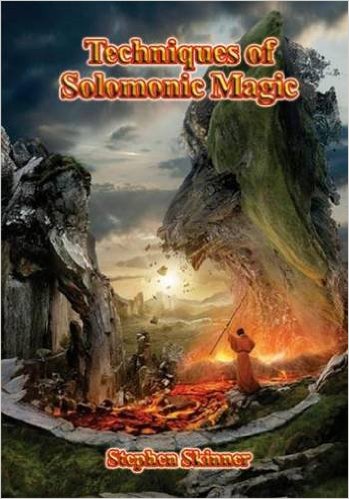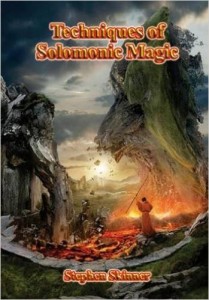Back in November, I posted about Golden Hoard’s release of Dr. Stephen Skinner’s <i>Techniques of Graeco-Egyptian Magic</i>, a fantastic overview of the little-understood (and oft-misunderstood) subject of its title. The practical application of this wealth of material was promised in a follow-on volume, which has now arrived in Skinner’s latest, Techniques of Solomonic Magic. According to the publisher’s website,
Solomonic magic is a major part of the grimoire tradition. This volume is about the methods of Solomonic magic used in Alexandria and how they have been passed via Byzantium (the Hygromanteia), to the manuscripts of the Latin Clavicula Salomonis and its English incarnation as the Key of Solomon. Jewish techniques like the use of pentacles, oil and water skrying were added along the way, but Solomonic magic (despite its name) remained basically a classical Greek form of magic. Amazingly, this transmission has involved very few changes and the ‘technology’ of magic has remained firmly intact. The emphasis in this book is upon specific magical techniques such as the invocation of the gods, the binding of demons, the use of the four demon Kings, and the construction of the circle and lamen. The requirements of purity, sexual abstinence, and fasting have changed little in the last 2000 years, and the real reasons for that are explained. The use of amulets, talismans and phylacteries or lamens is outlined along with their methods of construction. The structure of a Solomonic evocation puts into perspective the reasons for each step, the use of thwarting angels, achieving invisibility, sacrifice, love magic, treasure finding, and the binding, imprisoning and licensing of spirits.
The facing directions and timing of evocations have always been crucial, and these too have remained consistent. Practical considerations such as choice of incense, the timing of the cutting of the wand, utilisation of rings and statues, use of the Table of Evocation, or the acquisition of a familiar spirit are also explained. Techniques of Solomonic Magic is thus a follow on book from Techniques of Graeco-Egyptian Magic. This volume is based on the magicians’ own handbooks rather than the opinions of theologians, historians, anthropologists, sociologists or legislators. The emphasis is on what magicians actually did and why. Tools used by magicians in 7th century Alexandria, 15th century Constantinople and 19th century London are very much the same. More than 70 illustrations (many in colour) of magical equipment like the wand, the sword, wax images and magical gems, drawn from a wide range of manuscripts are reproduced and examined. This is the most detailed analysis of Solomonic magic, from the inside, ever penned.
The table of contents, posted at Golden Hoard’s site, is indeed impressive.
Running to 378 pages, with 30 tables and 68 illustrations (many in color), Techniques of Solomonic Magic is available in two formats: the regular hardcover sells for £46 (approximately $72), while a leather bound edition–limited to 200 copies–sells for £132 (approximately $210). Copies may be ordered at the publisher’s website. The volume is also available from Llewllyn Worldwide through your favorite bookstore.


